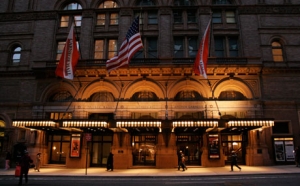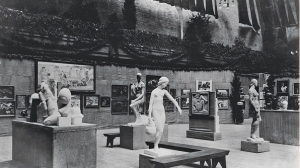|
Displaying items by tag: fauvism
“Russian Modernism: Cross-Currents of German and Russian Art, 1907-1917” at the Neue Galerie is a lively, scattershot exhibition, with numerous paintings of great interest, others of not so much and many by Russian artists most of us have barely heard of.
Containing 53 paintings and 21 works on paper, the show spans a decade when modern art movements were breaking out all over Europe — Fauvism, Expressionism, Cubism, Futurism, Dada and De Stijl. To the east, Russia was no exception. The show’s ambitious title introduces an immense subject that is beyond the resources of this small jewel-box museum.

On March 15, the Museum of Modern Art’s William S. Paley Collection will go on view at the Crystal Bridges Museum of American Art in Bentonville, Arkansas. “A Taste for Modernism” presents 62 works that cover all of the pivotal movements that defined the art world between 1880 and 1940. The exhibition features works by 24 major artists including Edgar Degas, Paul Cézanne, Paul Gauguin, Pablo Picasso, Henri Matisse, Alberto Giacometti, and Francis Bacon. The William S. Paley Collection has been on a North American tour since 2012. The Crystal Bridges Museum will be the last venue to host the exhibition before it returns to MoMA.
Highlights from the exhibition include two works by Cézanne, which Paley acquired from the artist’s son; eight works by Picasso that trace his artistic evolution over the first three decades of the 20th century, including “Boy Leading a Horse” from his Rose period, the Cubist painting “An Architect’s Table,” and the collage-inspired composition “Still Life with Guitar”; Gauguin’s “The Seed of the Areoi,” which was inspired by the artist’s trips to Tahiti; and realist landscapes by Edward Hopper.
William S. Paley, the media mogul who built the CBS broadcasting empire, was an important art collector and philanthropist. Paley began collecting in the 1930s and had a particular fondness for French modernist movements such as Fauvism, Cubism, and Post-Impressionism. Paley played a major role in establishing MoMA as one of the most significant institutions in the world and he fulfilled various roles at the museum including patron, trustee, president, and board chairman from 1937 until his death in 1999.
“A Taste for Modernism” will remain on view at the Crystal Bridges Museum of American Art through July 7.

On October 3, 2013, the American Symphony Orchestra will present New York Avant-Garde at Carnegie Hall in New York. The event was organized in partnership with the New-York Historical Society’s exhibition The Armory Show at 100: Modern Art and Revolution, which opens on October 11, 2013. Led by the Symphony’s Leon Botstein, New York Avant-Garde will celebrate the 100th anniversary of the legendary 1913 Armory Show by recreating the fall-out in music caused by the groundbreaking event. The show will include works by modernist composers including Edgar Varèse and Aaron Copland.
Organized by the Association of American Painters and Sculptors, the Armory Show, officially titled the International Exhibition of Modern Art, took place at the 69th Regiment Armory and introduced radical works of art to the public; a far cry from the realistic art they were accustomed to. Artists, critics, and patrons were presented with European works that boasted avant-garde sensibilities and spanned genres like Futurism, Cubism, and Fauvism. The show transformed the landscape of modern art and inspired an unmatched growth and progression in American art.

The Museum of Modern Art’s William S. Paley collection is currently on view at the Portland Museum of Art in Maine. A Taste for Modernism presents 62 works that cover all of the pivotal movements that defined the art world during the late 19th and 20th centuries. The exhibition features works by 24 major artists including Edgar Degas (1834-1917), Paul Cézanne (1839-1906), Paul Gauguin (1848-1903), Pablo Picasso (1881-1973), Henri Matisse (1869-1954), Joan Miró (1893-1983), Alberto Giacometti (1901-1966), and Francis Bacon (1909-1922). The William S. Paley collection has been on a North American tour since 2012 and the Portland Museum of Art is the only venue in New England that the exhibition will visit.
Highlights from the exhibition include two works by Cézanne, which Paley acquired from the artist’s son; eight works by Picasso that trace his artistic evolution over the first three decades of the 20th century including Boy Leading a Horse (1905-06) from his Rose Period, the Cubist painting An Architect’s Table (1912), and the collage-inspired composition Still Life with Guitar (1920); Gaugin’s The Seed of the Areoi (1892), which was inspired by the artist’s trips to Tahiti; and Edward Hopper’s (1882-1967) realist landscapes.
William S. Paley (1901-1999), the media mogul responsible for building the CBS broadcasting empire, was an important art collector and philanthropist during the 20th century. Paley began collecting in the 1930s and took a particular liking to French modernist movements including Fauvism, Cubism, and Post-Impressionism. Paley played a major role in cementing the Museum of Modern Art as one of the most significant institutions in the world. MoMA was founded in 1929 and Paley fulfilled various roles at the museum including patron, trustee, president, and board chairman from 1937 until his death.
A Taste for Modernism will be on view at the Portland Museum of Art through September 8, 2013. It will them travel to the Musée national des beaux-arts du Québec (October 10, 2013-January 5, 2013) and The Crystal Bridges Museum of American Art in Bentonville, Arkansas (February-April, 2014).

The 1913 International Exhibition of Modern Art, referred to today as the Armory Show, was one of the most influential art events to take place during the 20th century. The show, which was held in New York City’s 69th Regiment Armory, introduced the American public to experimental European art movements including Fauvism, Cubism, and Futurism. While realistic movements dominated the country’s art scene, works by Pablo Picasso (1881-1973), Henri Matisse (1869-1954), Wassily Kandinsky (1866-1944), and Marcel Duchamp (1887-1968) left the Armory Show’s American visitors awestruck.
On February 17, 2013, 100 years after the Armory Show took place, the Montclair Art Museum in Montclair, New Jersey presented The New Spirit: American Art in the Armory Show, 1913. The exhibition does more than just celebrate the significant art event; it commends the American artists who presented two-thirds of the nearly 1,200 works on view. While European art was a hugely important part of the Armory Show, The New Spirit aims to disprove the notion that the American art featured at the show was largely provincial.
The New Spirit brings together 40 diverse works of American modern art including realist works from the Ashcan School as well as more experimental pieces executed by the painters associated with the influential photographer and art dealer, Alfred Stieglitz (1864-1946). The Montclair exhibition presents works by well-known artists such as Edward Hopper (1882-1967), William Glackens (1870-1938), Marsden Hartley (1877-1943), Charles Sheeler (1883-1965), Robert Henri (1865-1929), and John Marin (1870-1953) alongside works by lesser-known artists including Manierre Dawson (1887-1969), Kathleen McEnery (1885-1971), and E. Ambrose Webster (1869-1935). The exhibition will also feature works by Paul Cézanne (1839-1906) and Matisse to illustrate the influence of European modern art on its American counterpart.
The New Spirit will be on view through June 16, 2013.

100 years after the seminal Armory Show in New York City, The Heckscher Museum of Art presents Modernizing America: Artists of the Armory Show. On view through April 14, 2013, the exhibition features works from the museum’s permanent collection and explores the show that changed the country’s perception of modern art.
Organized by the Association of American Painters and Sculptors, the Armory Show, officially titled the International Exhibition of Modern Art, took place at the 69th Regiment Armory and introduced radical works of art to the public; a far cry from the realistic art they were accustomed to. Artists, critics, and patrons were presented with European works that boasted avant-garde sensibilities and spanned genres like Futurism, Cubism, and Fauvism. The show transformed the landscape of modern art and inspired an unmatched growth and progression in American art.
Works on view include paintings by Marguerite Zorach (1877-1968) and Arthur B. Carles (1882-1952); works on paper by Joseph Stella (1877-1946), Oscar Bluemner (1867-1938), and Charles Sheeler (1883-1965); and sculptures by artists such as Walter Kuhn (1877-1949).
The Heckscher Museum of Art was founded in 1920 by August Heckscher in Huntington, New York. The museum boasts over 2,000 works and focuses mainly on American landscape paintings as well as American and European modernism and photography.
Could Vincent van Gogh's acidic sense of color and preference for bright, clashing hues, long the province of the Fauves, be a result of colorblindness and not just an aesthetic judgment? An essay by Kazunori Asada, a Japanese medical scientist and poet, has recently come to the attention of science blogs drawn to its argument that the famous painter wasn't so much an artistic revolutionary as he was visually impaired. Asada’s article was sparked by an experience in Hokkaido, Japan’s “Color Vision Experience Room,” an immersive simulator that makes it possible to perceive color the way people with different types of colorblindness might experience it. When Asada saw replicas of the artist’s canvases, he had a revelation.
|
|
|
|
|